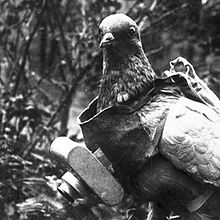
Back تصوير ضوئي للحمام Arabic Göyərçin fotoqrafiyası Azerbaijani পায়রা আলোকচিত্র Bengali/Bangla Colom fotògraf Catalan Holubí fotografie ze vzduchu Czech Duefotografering Danish Brieftaubenfotografie German Αεροφωτογράφιση από περιστέρια Greek Fotografía con palomas Spanish Tuvifotograafia Estonian

Pigeon photography is an aerial photography technique invented in 1907 by the German apothecary Julius Neubronner, who also used pigeons to deliver medications. A homing pigeon was fitted with an aluminium breast harness to which a lightweight time-delayed miniature camera could be attached. Neubronner's German patent application was initially rejected, but was granted in December 1908 after he produced authenticated photographs taken by his pigeons. He publicized the technique at the 1909 Dresden International Photographic Exhibition, and sold some images as postcards at the Frankfurt International Aviation Exhibition and at the 1910 and 1911 Paris Air Shows.
Initially, the military potential of pigeon photography for aerial reconnaissance appeared interesting. Battlefield tests in World War I provided encouraging results, but the ancillary technology of mobile dovecotes for messenger pigeons had the greatest impact. Owing to the rapid development of aviation during the war, military interest in pigeon photography faded and Neubronner abandoned his experiments. The idea was briefly resurrected in the 1930s by a Swiss clockmaker, and reportedly also by the German and French militaries. Although war pigeons were deployed extensively during World War II, it is unclear to what extent, if any, birds were involved in aerial reconnaissance. The United States Central Intelligence Agency (CIA) later developed a battery-powered camera designed for espionage pigeon photography; details of its use remain classified.
The construction of sufficiently small and light cameras with a timer mechanism, and the training and handling of the birds to carry the necessary loads, presented major challenges, as did the limited control over the pigeons' position, orientation and speed when the photographs were being taken. In 2004, the British Broadcasting Corporation (BBC) used miniature television cameras attached to falcons and goshawks to obtain live footage, and today some researchers, enthusiasts and artists similarly deploy crittercams with various species of animals.